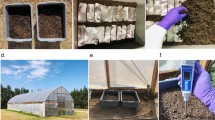Abstract
In this study, the effect of cotton treatment with cellulose and carboxymethyl cellulose on soil release of three different types of fabric: woven plain, woven twill and knitted were systematically studied. A recent study of the effect of a cleaning cellulase enzyme on cellulose films has proven that this substance selectively attacks amorphous cellulose regions, consisting of small hills in a matrix of flat crystalline regions. According to our previous investigations, where carboxymethyl cellulose is present in the formula, the enzyme seems to drive soil release performance. However, the mechanism has not yet been sufficiently studied from the topographical standpoint. In the present study, topographical changes caused by the treatment with cleaning cellulase enzyme and carboxymethyl cellulose on the fabrics by conditioning while washing were analysed on three different length scales in order to interpret their cooperation on water and oil absorption mechanisms and, hence, on cleanability of cotton fabrics stained with liquid–solid, liquid and solid soils.












Similar content being viewed by others
Abbreviations
- CCE:
-
Cleaning cellulose enzyme
- CMC:
-
Carboxymethyl cellulose
References
Novozymes Web Page (2010) http://www.novozymes.com/en/MainStructure/AboutUs/Positions/Detergent+enzymes.htm. (11.11.2010)
Hauthal HG (2008) Basics, ingredients, detergents, product safety and sustainability, Third European Detergents Conference Report., Tenside Surfactant Deterg 45:30–42
Calvimontes A, Stamm M, Dutschk V (2009) Effect of cellulase enzyme on cellulose nano-topography. Tenside Surfactant Deterg 46(6):368–372
Hasan MMB, Calvimontes A, Synytska A, Dutschk V (2008) Effects of topographic structure on wettability of differently woven fabrics. Tex Res J 78(11):996–1003
Calvimontes A, Synytska A, Dutschk V, Bell Ch, Lehmann B (2006) Einfluss der Struktur von Polyestergewebe auf ihre Benetzbarkeit. Melliand Textilberichte 1(2):64–67, and Melliand English 1(2):E16–E18
Dutschk V, Myat S, Märtin J, Stolz M, Breitzke B, Cherif Ch, Heinrich G (2007) A comparative analysis between different ether carboxylic acids with respect to wettability and surface topography of abrasively treated polyester fabrics. Tenside Surfactant Deterg 44(6):248–254
Calvimontes A, Dutschk V, Breitzke B, Offermann P, Voit B (2005) Soiling degree and cleanability of differently treated polyester textile materials. Tenside Surfactant Deterg 42(1):17–22
Calvimontes A, Dutschk V, Koch H, Voit B (2005) New detergency aspects through visualisation of soil release polymer films on textile surfaces. Tenside Surfactant Deterg 42(4):210–216
Hasan MMB, Dutschk V, Calvimontes A, Hoffmann G, Heinrich G, Cherif Ch (2008) Influence of the cross-sectional geometry on wettability and cleanability of polyester woven fabrics. Tenside Surfactant Deterg 45(5):274–279
Hasan MMB, Calvimontes A, Dutschk V (2009) Correlation between wettability and cleanability of polyester fabrics modified by soil release polymer and their topographic structure. J Surfactant Deterg 12:285–294. doi:10.1007/s11743-009-1130x
Calvimontes A (2010) Topography and the mechanistic understanding of wetting. Südwestdeutscher Verlag für Hochschulschriften, Saarbrücken-Deutschland. ISBN 978-3-8381-2318-9
Calvimontes A, Dutschk V, Stamm M (2009) Advances in topographic characterization of textile materials. Tex Res J 80(11):1004–1015. doi:10.1177/0040517509348331
Jacobasch HJ, Grosse I (1978) Möglichkeiten und Grenzen der Modifizierung von Synthesefaserstoffen zur Erziehung schmutzabweisender Eigenschaften. Textiltechnik 28(2):98–103
Calvimontes A, Dutschk V, Cherif C, Heinrich G (2007) Ein neues Konzept zum besseren Verständnis der Penetration von Flüssigkeiten in textilien Oberflächenstrukturen, Beschichtung und Modifizierung von Kunststoffoberflächen: NDVaK, 15. Neues Dresdner Vakuumtechnisches Kolloquium, Dresdner Transferstelle für Vakuumtechnik e.V.:48–52. ISBN 978-3-00-022604-5
Dutschk V, Sabbatovskiy KG, Stolz M, Grundke K, Rudoy VM (2003) Unusual wetting dynamics of aqueous surfactant solutions on polymer surfaces. J Colloid Interf Sci 267:456–462
Rees WH (1954) The soiling of textile materials. J Text Inst 45:612–631
Flath HJ (1968) Prüfmethoden für die Anschmutzung von Textilien. Deutsche Textiltechnik 18:97–105
Calvimontes A (2004) Schmutzabweisende Eigenschaften von Textil—und Polymermaterialien durch Imprägnierung mit Soil-Release-Polymeren, M.Sc. Thesis in Textile and Clothing Engineering, Technischen Universität Dresden, Fakultät Maschinenwesen, Institut für Textil—und Bekleidungstechnik, Dresden, Germany
Stout KJ, Sullivan PJ, Dong WP, Mainsah E, Luo N, Mathia T, Zahouani H (1993) The development of methods for the characterisation of roughness in three dimensions. Commission of the European Communities, Brussels-Luxembourg. ISBN 0 7044 1313 2
Acknowledgments
We would like to acknowledge Procter & Gamble for financial support and to Mr. Stefan Werner for physical–chemical characterisation of particulate soils.
Author information
Authors and Affiliations
Corresponding author
About this article
Cite this article
Calvimontes, A., Lant, N.J. & Dutschk, V. Cooperative Action of Cellulase Enzyme and Carboxymethyl Cellulose on Cotton Fabric Cleanability from a Topographical Standpoint. J Surfact Deterg 14, 307–316 (2011). https://doi.org/10.1007/s11743-011-1248-5
Received:
Accepted:
Published:
Issue Date:
DOI: https://doi.org/10.1007/s11743-011-1248-5




